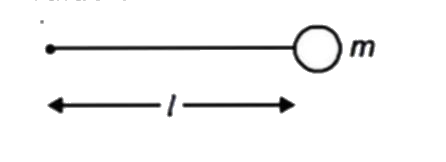A block of mass M is suspended from a wire of length L, area of cross-section A and Young's modulus Y. The elastic potential energy stored in the wire is
12M2g2LAY
12MgALY
12M2g2AYL
12MgYAL
The correct Answer is:A
To find the elastic potential energy stored in the wire when a block of mass M is suspended from it, we can follow these steps:
1. Identify the Forces and Parameters:
- The block of mass M exerts a force due to gravity, which is F=Mg.
- The wire has a length L, cross-sectional area A, and Young's modulus Y.
2. Understand Young's Modulus:
- Young's modulus Y is defined as the ratio of stress to strain:
Y=StressStrain=FAΔLL
- Rearranging gives:
ΔL=FLAY
3. Substitute the Force:
- Substitute F=Mg into the equation for extension ΔL:
ΔL=MgLAY
4. Determine the Spring Constant k:
- The spring constant k for the wire can be derived from the relationship between force, extension, and spring constant:
F=kΔL⟹k=FΔL
- Substituting F=Mg and ΔL=MgLAY:
k=MgMgLAY=AYL
5. Calculate the Elastic Potential Energy U:
- The elastic potential energy stored in the wire is given by:
U=12k(ΔL)2
- Substitute k and ΔL:
U=12(AYL)(MgLAY)2
6. Simplify the Expression:
- Simplifying the expression:
U=12⋅AYL⋅M2g2L2A2Y2
- Cancel out terms:
U=12⋅M2g2LAY
7. Final Result:
- The elastic potential energy stored in the wire is:
U=M2g2L2AY
- The block of mass M exerts a force due to gravity, which is F=Mg.
- The wire has a length L, cross-sectional area A, and Young's modulus Y.
- Young's modulus Y is defined as the ratio of stress to strain:
Y=StressStrain=FAΔLL
- Rearranging gives:
ΔL=FLAY
- Substitute F=Mg into the equation for extension ΔL:
ΔL=MgLAY
- The spring constant k for the wire can be derived from the relationship between force, extension, and spring constant:
F=kΔL⟹k=FΔL
- Substituting F=Mg and ΔL=MgLAY:
k=MgMgLAY=AYL
- The elastic potential energy stored in the wire is given by:
U=12k(ΔL)2
- Substitute k and ΔL:
U=12(AYL)(MgLAY)2
- Simplifying the expression:
U=12⋅AYL⋅M2g2L2A2Y2
- Cancel out terms:
U=12⋅M2g2LAY
- The elastic potential energy stored in the wire is:
U=M2g2L2AY
Topper's Solved these Questions
- PROPERTIES OF MATTERBook:DC PANDEYChapter:PROPERTIES OF MATTERExercise:More than one option is correct
Explore 21 Videos
- PROPERTIES OF MATTERBook:DC PANDEYChapter:PROPERTIES OF MATTERExercise:Comprehension
Explore 32 Videos
- PROPERTIES OF MATTERBook:DC PANDEYChapter:PROPERTIES OF MATTERExercise:Integer
Explore 8 Videos
- PROJECTILE MOTIONBook:DC PANDEYChapter:PROJECTILE MOTIONExercise:Level - 2 Subjective
Explore 10 Videos
- RAY OPTICSBook:DC PANDEYChapter:RAY OPTICSExercise:Integer type q.
Explore 15 Videos
Similar Questions
A particle of mass m is attached to a metallic wire of length l, area of cross-section A and Young's modulus of elasticity Y . If the extension in the wire at an instant the string becomes vertical after the particle is released and moves in a verticle circle is nmglAY. Find the value of n.

View SolutionAn object of mass m is suspended at the end of a massless wire of length L and area of cross -section A. Young modulus of the material of the wire is Y. If the mass is pulled down slightly its frequency of oscillation along the vertical direction is :
View Solution
Knowledge Check
A metal wire of length L, area of cross-section A and Young's modulus Y behaves as a spring of spring constant k.
Ak=YA/LBk=2YA/LCk=YA/2LDk=YL/AWhen a block of mass M is suspended by a long wire of length L, the length of the wire becomes (L+l). The elastic potential energy stored in the extended wire is
A12MgLBMglCMgLD12MglWhen a block of mass M is suspended by a long wire of length L, the length of the wire becomes (L+l). The elastic potential energy stored in the extended wire is
AMglBMgLC12MglD12MgL
A uniform wire of mass m, length L, area of cross-section A and Young's modulus Y hange from the ceiling. Its elongation under its own weight will be
View SolutionIf a metal wire of length L, having area of cross-section A and Young's modulus Y, behaves as a spring constant K. The value of K is
View SolutionIf a metal wire of length L, having area of cross-section A and young' s modulus Y . Behave as a spring of spring constant K. The value of K is
View SolutionA block of mass 500kg is suspended by wire of length 70 cm. The area of cross-section of wire is 10 mm2. When the load is removed, the wire contracts by 0.5cm. The young's modulus of the material of wire will be
View SolutionA mass (m) is suspended at the end of a weightless wire of length L, cross-sectional area A and Young's modulus Y. The period of oscillation for the S.H.M. along the vertical direction is
View Solution